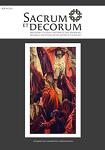Neoplatońska Wieczerza
The Neo-Platonic Supper
Author(s): Tadeusz BorutaSubject(s): Cultural history
Published by: Wydawnictwo Uniwersytetu Rzeszowskiego
Keywords: neo-Platonism; the Eucharist; emanation; eschatological vision; Polish painting
Summary/Abstract: The article concerns The Last Supper by Maciej Świeszewski, one of the best known Polish paintings of recent years. The piece presents an eschatological feast. A sumptuous banquet table, whose rectangular shape represents earthly reality, along with the apostles, is placed in a nebulous, heavenly space of a New Jerusalem. In addition, the artist produces an interesting and meticulously studied image of Jesus. By giving him three faces, he creates an entirely new iconography. This original vision originates along the central axis of the composition and radiates to the rest of the painting. Starting from the top, the viewer comes across the vertex of a triangle. The triangle is white to represent the primordial neo-Platonic unity of God; as it descends, it gradually splits into the colours of the rainbow, the symbol of reconciliation, mercy and covenant between the Creator and his creation, as well as the presence of God. The banquet table, overflowing with the fruits of the earth, floating on the endless expanse of water is at once an ark and a sacrificial table. The paintings by Maciej Świeszewski and Aldona Mickiewicz show the scene of the Last Supper in the symbolic light of Neo-platonic philosophy. In the former, a primal tear of God falls on earthly waters, creating new life and starting waves, which emanate from the centre to include the entire painting in symbolic circles of eschatological symbols. In the latter, the square of the table (representing the earthly) is covered with a tablecloth; in the vein of Renaissance architects, who tried to design an ideal temple, a circle formed by crumbs of bread and folds of the tablecloth is inscribed within it. The centre of emanation is the Eucharist, represented by the plate with bread and the wine-filled carafe. Aldona Mickiewicz thus creates a symbolic image of the community of the mystical Church. However, she is uncertain in her vision, stops at the description of the everyday, and openly shares her doubts. Her paintings are not statements but question marks asking about the essence of life. In her The Last Supper, she freezes the moment of rolling up the tablecloth to express her doubt as to whether it will unveil an empty, earthly table or the promised Kingdom of God. Świeszewski, on the other hand, is a visionary. It seems that his enormous erudition and, perhaps, personal faith allow him to steal a glance at the nuptial feast of the Triumphant Church – the wedding of the Lamb.
Journal: Sacrum et Decorum. Materiały i studia z historii sztuki sakralnej
- Issue Year: 2011
- Issue No: 4
- Page Range: 65-79
- Page Count: 15
- Language: Polish

